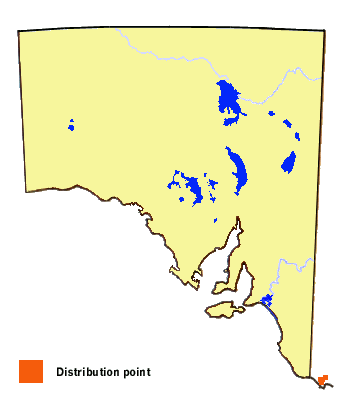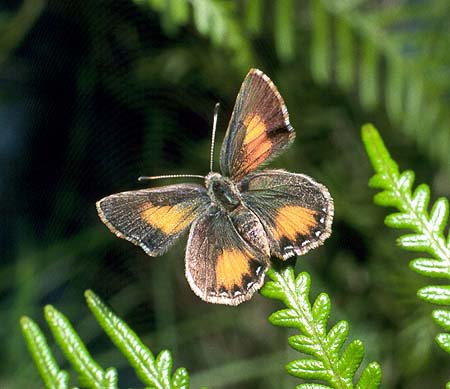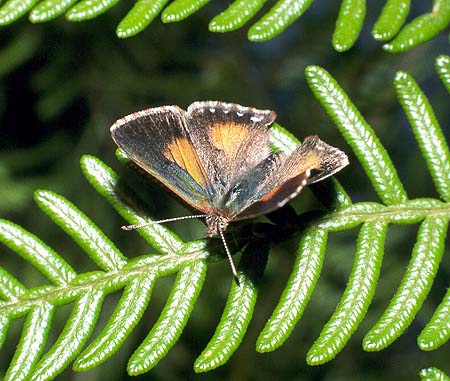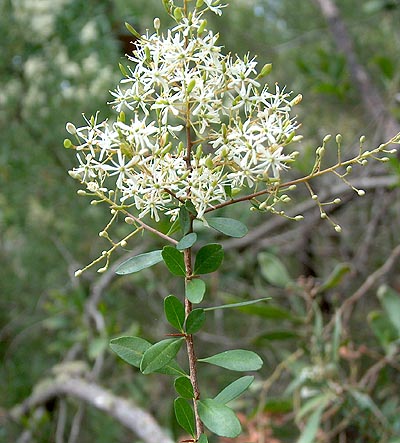-
Larval Food Host
-
Larvae usually feed on Bursaria spinosa (Christmas bush) (Pittosporaceae)
in southwest Victoria. The larvae eat the leaves and soft new growth of the foodplant.
-
Larval Attendant Ant
-
Larvae are attended by very small black ants
Anonychomyrma (Iridomyrmex) (nitidiceps group) and also probably
Notoncus species. The former ants scatter quickly when danger threatens.
-
Eggs
-
Small, initially greenish white, later turning white, sub-conical, with a very fine
reticulated pattern. The reticulations are trigonal (ordered into hexags), and at
each intersection there is a short raised spine. The egg is apically flattened with
a depressed micropylar area. Laid singly or in small clusters, usually within the
new growing tips of the foodplants, but also sometimes on older leaves or on the young
stems. The eggs start to hatch after about 7 days in late spring.
Females prefer to lay eggs on small plants below 1.5 m in height, and actually choose
plants or a site on the plants that lack an active presence of the attendant ants.
The ants colonise (or recolonise) the plant once the larvae are active, which they do by
building a network of below-ground chambers at the base of the foodplant that are separate
from the main ant nest. These chambers provide protected resting places for the
larvae during the day and eventually sometimes the pupae. At the beginning of the
flight season the foodplants are rarely seen to have attendant ants.
-
Larvae
-
The first instar is long onisciform shaped, pale yellow with a broken, reddish subdorsal
line. The posterior dorso-lateral organs are not developed. The head is small, smooth,
dark yellowish brown, hidden beneath the body. The prothoracic plate is very large,
dark brown coloured with about three short pairs of dark, forward directed hairs,
the dark anal plate is small. There are long peripheral white setae, which are longest
posteriorly. There are paired, long black recurved dorsal setae, which are very long
anteriorly and then gradually decrease in length posteriorly along the body until the
last posterior segment where they become very long again. They occur on thoracic segments
(TS) 2 and 3, and on the first six abdominal segments (AS) and again on the last.
On the 7th AS there is a short pair of flattened white setae directed to the rear.
After eating the foodplant, the larvae gradually become greenish anteriorly, and whitish
dorsally, and aquire narrow reddish dorsal, subdorsal and lateral lines. They feed
initially by scouring the leaf cuticle from the leaves of the foodplant, but after about
the second instar they will eat the entire leaf.
Intermediate instars are onisciform (slater shaped) and gradually lose the long dorsal
setae and gain the posterior dorso-lateral organs, and are brown coloured similar to the
final instar. The prothoracic plate remains large and black coloured. Tiny secondary
setae become increasingly numerous which give the larvae a scabrous appearance.
Larvae feed at night accompanied by attendant ants, and hide during the day in cavities
made by the ants beneath the ground around the base of the hostplant.
Mature larvae are 13-15 mm long.
-
Pupae
-
9-10 mm long.
-
Flight Period in South Australia
-
In southwest Victoria the butterfly has an extended flight period from about October to March,
the result of continuous broods, which can be completed in about 10-13 weeks. Elsewhere in
Victoria there are additional records in August, September and April. Eggs laid during autumn
produce the next spring flight. It overwinters as larvae. However, as with most colonistic
Lycaenids there can be staggered larva development and there are records in captivity of eggs
laid in spring producing larvae that required a full year for development.

-
Distribution
-
The butterfly has yet to be recorded in South Australia. It occurs in southwest Victoria,
35 km from the SA-Vic border, and so it is expected that this butterfly may eventually
be found in SA, either as vagrants or small resident populations. The range of the
butterfly extends throughout the moist montane and coastal areas of Victoria, NSW and
southeast Queensland. It is also found in eastern Tasmania.

-
Habitat
-
The butterfly has a preference for cool, damp (often leech prone), shady, temperate forest areas
receiving more than about 750 mm of annual rainfall. It requires open sunlit areas and the
understorey to be open and not overly congested by bracken and tea-tree, or similar plants.
-
Conservation Status in South Australia
-
Likely to be extremely rare and localised if found in South Australia,
although in the adjacent areas of Victoria where there has been a better
retention of native forests, the butterflies can be locally common.
-
Threats
-
Suitable cool, moist, tall forest habitat with an uncongested understorey is now
extremely rare in SA. Such habitat was long ago fragmented and degraded, or turned
into pine plantations. The remaining areas are now under constant threat from
bushfires and understorey degradation from the invasion of bracken. Bushfires,
drought, and urban and forestry expansion would likely be the main threats under
present conditions.
-
Conservation Strategy
-
If colonies of the butterfly were found, then they would need to be monitored to
prevent invasion by choking exotic weeds to their habitat. Toxic agricultural
and forestry insecticides and weedicides used in adjacent areas would need to be
judiciously applied, particularly those sprays distributed by aerial means.
The butterfly should be a good candidate for reintroduction into conserved areas.




